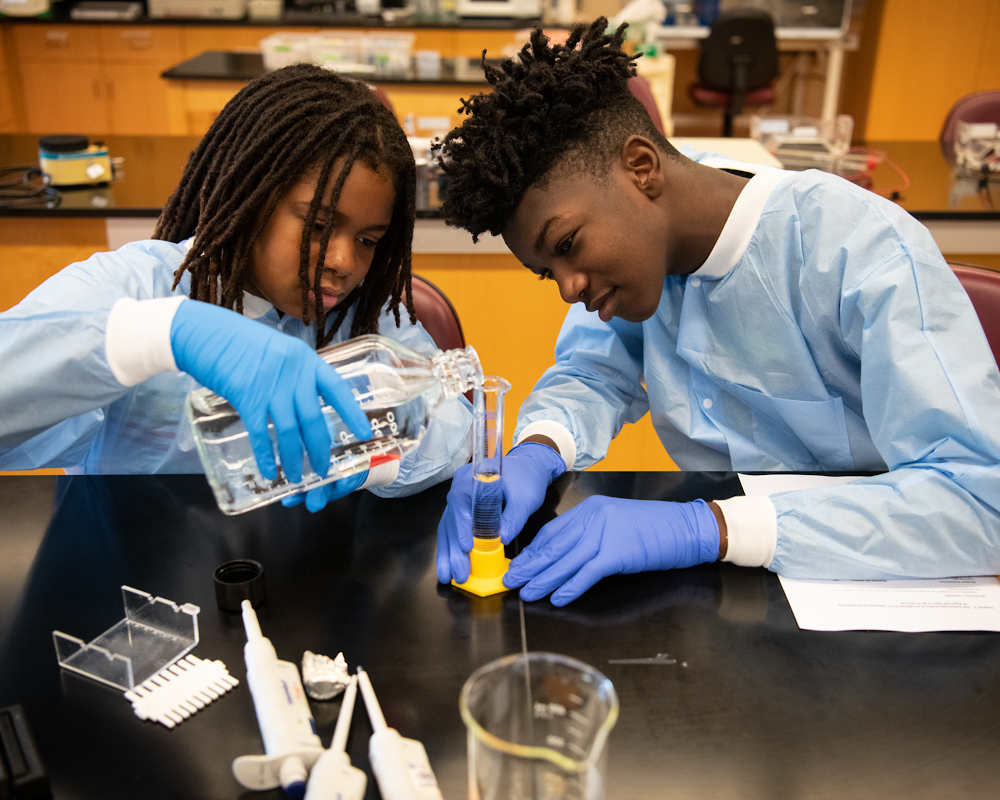UMB CURE Wins National ‘Inspiring Program’ Award
Explore. Excite. Inspire.
These are the main goals of the University of Maryland, Baltimore’s (UMB) CURE Scholars Program, an initiative launched in 2015 to help West Baltimore students pursue and excel in STEM (science, technology, engineering, and math) education with an eye on exploring career opportunities in the research, STEM, and health care fields.
UMB CURE was honored in the “Inspire” domain on Aug. 15, winning a 2020 Inspiring Programs in STEM Award from INSIGHT Into Diversity magazine, the largest and oldest diversity and inclusion publication in higher education. The award recognizes colleges and universities that encourage and assist students from under-represented groups to enter the STEM fields. UMB and 49 other recipients will be featured in the magazine’s September issue.

Aniyaa Green (left) and Dayon Wilson (right), CURE Scholars in cohort 1, make a gel for a gel electrophoresis during the Biotechnology Bootcamp at Baltimore City Community College (photo taken in July 2019).
“It’s truly an honor to be recognized as an inspiring STEM program,” said UMB CURE executive director Gia Grier McGinnis, DrPH, MS. “It’s a reflection of UMB’s commitment to producing the next generation of health care and STEM leaders through engaging year-round programming, high-quality mentoring, and strong social support services.”
UMB Interim President Bruce E. Jarrell, MD, FACS, said the award is well-deserved. “The UMB professionals who run the program, mentors, community partners, and scholars’ families all work together to create meaningful opportunities, inspire, and engage what I hope will be the next generation of health and science leaders,” he said. “The scholars inspire the UMB community in return as we see what amazing results come from being given the opportunity to shine.”
UMB CURE is the first National Cancer Institute (NCI) Continuing Umbrella of Research Experiences (CURE) pipeline program to offer year-round mentorship, STEM programming, tutoring, and hands-on learning opportunities to middle school students. The program identifies sixth-graders with an interest in science from three West Baltimore schools, then supports them through middle school, high school, and beyond.
CURE Scholars are selected based on their commitment to a long-term program and not on academic performance measures. Through rich scientific opportunities, they gain presentation experience, academic growth, self-confidence, and the motivation necessary to succeed.
Bret Hassel, PhD, a professor in the Department of Microbiology and Immunology at the University of Maryland School of Medicine and a member of the UMB CURE leadership team, was thrilled to learn the program had been recognized by INSIGHT Into Diversity.
“The well-deserved recognition of the CURE Scholar Program’s local impact has inspired and will continue to inspire peer programs across the country,” said Hassel, who was a key contributor to the award application along with Jena Frick, senior media relations specialist in UMB’s Office of Communications and Public Affairs. “These efforts are essential to provide a biomedical workforce that reflects the makeup of our population and will benefit from the enhanced creativity and productivity that are fostered by diverse perspectives.”
In the application, Hassel wrote, “UMB state-of-the-art research and clinical facilities and faculty expertise in education, biomedical research, patient care, and community service provide an ideal environment for students to gain hands-on experience in biomedical research under the mentorship of near-peer trainees and health care professionals.
“With diversity and inclusion as a focus of institutional excellence, UMB has developed a STEM education pipeline composed of 10 programs that span middle school through postgraduate training.”
The application noted UMB CURE’s success through five years, with 144 students entering the program in sixth grade and 150 student and faculty mentors volunteering to provide after-school, weekend, and summer STEM programming. The scholars have developed capstone projects and given presentations on STEM topics at national meetings as well as to city, state, and National Institutes of Health officials. The program’s retention rate is more than 80 percent, with the students showing academic improvement and entering top-tier high schools, the application noted.
In recognition of its strong STEM education pipeline, UMB was selected to host the first-ever Diversity Pipeline Programs Meeting in 2019. This meeting brought together leadership, staff, and trainees from programs across the country to identify best practices and develop capacity-building opportunities that will promote the engagement of under-represented students in STEM fields nationwide. The program also has fostered strong community support, with the CURE Parent Organization gaining representation on the UMB CURE Advisory Board.
UMB CURE also will be introducing a Career Navigators component in fall 2020 that is geared toward 11th- and 12th-grade students and is partially funded by the Jack and Jill of America Foundation and the Edward St. John Foundation. Career Navigators will support scholars in submitting college applications, navigating financial aid forms, acquiring internships and apprenticeships, and connecting with STEM professionals working in their area of interest.
“We know that many STEM programs are not always recognized for their success, dedication, and mentorship for under-represented students,” said Lenore Pearlstein, co-publisher of INSIGHT Into Diversity. “We want to honor the schools and organizations that have created programs that inspire and encourage young people who may currently be in or are interested in a future career in STEM. We are proud to honor these programs as role models to other institutions of higher education and beyond.”



